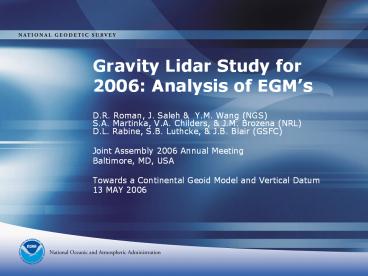Gravity Lidar Study for 2006: Analysis of EGM - PowerPoint PPT Presentation
Title:
Gravity Lidar Study for 2006: Analysis of EGM
Description:
Gravity Lidar Study for 2006: Analysis of EGMs – PowerPoint PPT presentation
Number of Views:25
Avg rating:3.0/5.0
Title: Gravity Lidar Study for 2006: Analysis of EGM
1
Gravity Lidar Study for 2006 Analysis of EGMs
- D.R. Roman, J. Saleh Y.M. Wang (NGS)
S.A. Martinka, V.A.
Childers, J.M. Brozena (NRL)
D.L. Rabine, S.B. Luthcke,
J.B. Blair (GSFC) - Joint Assembly 2006 Annual Meeting
- Baltimore, MD, USA
- Towards a Continental Geoid Model and Vertical
Datum - 13 MAY 2006
2
Abstract
- Aerogravity and lidar data were collected in the
littoral and onshore regions of the Florida
panhandle, Alabama, Mississippi, and Louisiana as
the second part of a three year study. These data
were collected principally in 41 lines oriented
north-south spaced at 10 km and collected at
35000 ft (greater than 10 km to mitigate
aliasing). Individual lines were 500 km long,
hence the full extent of the region is 400 km by
500 km. Weather conditions were fair throughout
the survey, consequently most of the signal was
retained along the profiles. - These data will be used to test for long
wavelength trends and biases in Earth Gravity
Models derived from the GRACE gravity mission.
These data provide sufficient coverage to analyze
the gravity field to degree and order 100, which
should be sufficient for analyzing the GRACE
contribution. Additionally, they will be used to
detect local systematic problems of existing
surface gravity data both onshore and offshore.
In last years study, inaccurate shipborne
gravity data were determined to have had
decimeter impact on the coastal geoid accuracy. - The lidar data are not expected to be ready by
the time of the meeting, however, they are
intended to be combined with available
high-accuracy tidal models to validate the
absolute accuracy of the derived gravimetric
geoid for this region.
3
Background
- Second year of three year study of Gulf of Mexico
- Funded flown by NOAA using NRLs gravity meter
and NASAs LVIS lidar - Collects aerogravity starting above stable
onshore areas to deep offshore areas established
by altimetry - Detects systematic errors in ship and terrestrial
data - For southern Louisiana subsidence region, may be
used to estimate effects of listric faulting
(slumping) - Lidar will be used in conjunction with
hyper-accurate regional tide models to check
geoid and MDT models
4
Equipment
- Aircraft Cessna Citation II
- NOAA AOC provided flight hours/crew
- Dual GPS antennas and receivers
- Independent antenna/receiver for each meter
- Lacoste-Romberg Air-Sea Gravimeter II
- Naval Research Lab equipment/personnel
- First Applanix POSAV mounted to collect INS
- Laser-Vegetation Imaging Sensor (LVIS)
- NASA Remote Sensing Lab equipment/personnel
- Second Applanix POSAV mounted to collect INS
5
Data Collection Parameters
- Tracks should resolve gravity/geoid field to 20
km - Flights are at 35000 ft (10 km) elevation
- Track spacing is 10 km perpendicular to shoreline
- Provides most of the signal
- Avoids spectral aliasing
- Cross-tracks at 50 km parallel to shoreline
- Speed over Ground is around 280 kts (500 kmh)
- Along track filtering is expected to yield 20 km
- Flight legs expected to be between 1-2 hours
6
Data Collection Process
- Flight departures based on predicted PDOP spikes
in GPS satellites and availability of restricted
airspace - One hour prior to take off
- prep ground GPS stations (replace batteries,
etc.) - Spin up gravity meter/calibrate
- Predetermine Eotvos correction for inflight
- Load memory cards
- During flight
- Calibrate LVIS in clear skies over open ocean
- Minimize bank in turns for both meters
7
Data Collection Process (cont.)
- Principal flight legs are 500 km long at 500 kmh
- Take-off, line up for first run, fly one hour
- Easy turn (Williamson) to minimize banking
- One hour back up return leg then land
- Most flights in around the three hour mark
- While on ground for about an hour
- Swap out batteries/memory cards
- Keep GPS on! Both onboard and ground stations
- Helps to calibrate the antennas later
- If time, weather, and airspace access permit do
it again
8
M1
M2
M3
M4
M5
M6
M7
M8
M10
M9
M11
M12
M13
M14
M15
M16
M17
M18
M20
M19
M21
M22
M23
M24
M25
M26
M27
M28
M30
M29
J1
J2
J3
J4
J5
J6
J7
J8
J10
J9
J11
J12
J13
J14
J15
J16
J17
J18
J20
J19
J21
J22
J23
J24
J25
J26
T1
T2
T3
T4
T5
T6
T7
T8
9
(No Transcript)
10
(No Transcript)
11
(No Transcript)
12
(No Transcript)
13
(No Transcript)
14
(No Transcript)
15
(No Transcript)
16
(No Transcript)
17
Possible Comparison INTERMAP
18
QUESTIONS?































